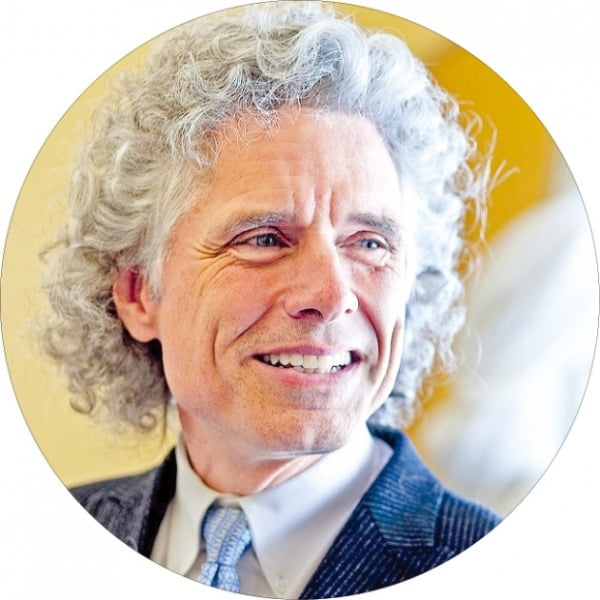
<svg version="1.1" xmlns="http://www.w3.org/2000/svg" xmlns:xlink="http://www.w3.org/1999/xlink" x="0" y="0" viewBox="0 0 27.4 20" class="svg-quote" xml:space="preserve" style="fill:#666; display:block; width:28px; height:20px; margin-bottom:10px"><path class="st0" d="M0,12.9C0,0.2,12.4,0,12.4,0C6.7,3.2,7.8,6.2,7.5,8.5c2.8,0.4,5,2.9,5,5.9c0,3.6-2.9,5.7-5.9,5.7 C3.2,20,0,17.4,0,12.9z M14.8,12.9C14.8,0.2,27.2,0,27.2,0c-5.7,3.2-4.6,6.2-4.8,8.5c2.8,0.4,5,2.9,5,5.9c0,3.6-2.9,5.7-5.9,5.7 C18,20,14.8,17.4,14.8,12.9z"></path></svg>In this century, the most famous argument that language is like an instinct comes from Noam Chomsky, the linguist who first unmasked the intricacy of the system and perhaps the person most responsible for the modern revolution in language and cognitive science. In the 1950s the social sciences were dominated by behaviorism, the school of thought popularized by John Watson and B. F. Skinner. Behavior was explained by a few laws of stimulus-response learning that could be studied with rats pressing bars and dogs salivating to tones. But Chomsky called attention to two fundamental facts about language. First, virtually every sentence that a person utters or understands is a brand-new combination of words, appearing for the first time in the history of the universe. The second fundamental fact is that children develop these complex grammars rapidly and without formal instruction and grow up to give consistent interpretations to novel sentence constructions that they have never before encountered. Therefore, he argued, children must innately be equipped with a plan common to the grammars of all languages, a Universal Grammar, that tells them how to distill the syntactic patterns out of the speech of their parents.<the :="" and="" instinct="" language="" mind="" new="" of="" science="" the="">
- Steven Pinker <<br />The Language Instinct: The New Sciensce of Language ans Mind ><the :="" and="" instinct="" language="" mind="" new="" of="" science="" the="">에서 -
이번 세기 들어 언어는 본능과 같다는 가장 유명한 주장은 노엄 촘스키로부터 비롯됐다. 그는 언어 시스템의 복잡성을 최초로 밝힌 학자이고, 오늘날의 언어와 인지 과학 혁명을 일으킨 인물이다. 1950년대 사회과학은 존 왓슨과 B F 스키너에 의해 널리 알려진 행동주의 학파에 장악됐다. 막대기를 누르는 쥐와 신호음에 침을 흘리는 개를 통해 자극과 반응으로 이뤄지는 학습이 연구됐고, 이 학습과 관련된 몇 개 법칙으로 행동은 설명됐다. 하지만 촘스키는 언어에 대한 두 가지 근본적인 사실에 주의를 환기시켰다. 첫 번째, 사람이 발화하고 이해하는 모든 문장은 사실상 새로운 방식으로 이뤄지는 어휘들의 조합이고, 우주 역사상 가장 처음으로 나타나는 것이다. 두 번째 근본적 사실은 아이는 이런 복잡한 문법을 빨리 습득하고, 정규 교육 없이도 습득하며, 이전에 한 번도 접하지 않은 새로운 문장 구조에 대한 일관적인 해석을 할 수 있게끔 성장한다. 그러므로 촘스키는 아이는 선천적으로 모든 언어의 문법에 공통적으로 나타나는 방침인 보편문법을 갖고 태어난다고 주장했는데, 보편문법을 통해 아이는 부모의 발화로부터 구문적 패턴을 포착한다.
< 해설 >
한국어는 명사를 수식하는 요소가 주로 명사의 앞에 위치하는 반면, 영어는 명사 뒤에 수식어가 오는 경향이 있습니다. 본문에 있는 예를 들어보도록 하겠습니다. the school of thought popularized by John Watson and B. F. Skinner를 보면 popularized는 ‘널리 알려진’이라는 수동의 의미를 갖고, 바로 앞에 있는 명사를 수식하는 역할을 합니다.
다음으로, rats pressing bars and dogs salivating to tones에서 명사 다음에 ~ing 형태의 요소가 오는 경우, [명사 + ~ing]는 ‘~하는 명사’라고 해석할 수 있습니다. 그래서 rats pressing bars는 ‘막대기를 누르는 쥐’, 그리고 dogs salivating to tones는 ‘신호음에 침을 흘리는 개’라고 해석하면 됩니다. 중요한 것은 [명사 + ~ing] 형태에서 명사는 수식어가 의미하는 행위를 하는 주체라는 것입니다. 마지막으로 본문에 나와 있는 a plan common to the grammars of all languages는 어떻게 해석이 될까요? 명사 plan 다음에 common to(~에 공통된)가 나오는데요, 이처럼 명사 다음에 바로 형용사가 나오면 뒤에 있는 형용사로 시작되는 구가 앞에 위치하는 명사를 수식한다고 생각하면 됩니다.
명사 다음에 수동태에서 사용되는 동사 형태, ~ing, 그리고 형용사가 나오면 왜 그 앞에 있는 명사를 수식할까요. 이는 앞의 명사를 수식하는 관계절에서 [관계대명사 + be 동사]가 탈락될 수 있다는 사실에서 그 답을 찾을 수 있습니다. 즉, the school of thought popularized by John Watson and B. F. Skinner는 the school of thought which was popularized by John Watson and B. F. Skinner의 문장 구조를 가지며, 명사 뒤에 위치한 관계절이 명사를 수식합니다. 그런데 여기서 밑줄 친 [관계대명사 + be 동사]가 탈락돼 본문의 문장을 만들어 내는 것입니다.
관련뉴스














